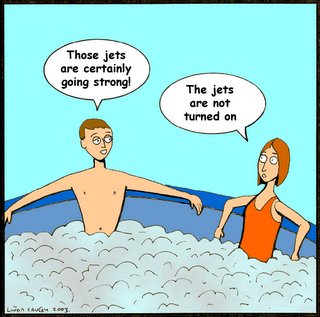
I was strapping an intoxicated patient onto a stretcher with leather restraints because he kept giving wet willies to one of the nurses in the ER. While doing so according to the nurses orders, I was trying to be as considerate as possible. As I tightened one of the restraints, I asked him if that felt alright. In response he said that that was like letting one rip and asking if that smelled alright.
That got me thinking about farting. What exactly is a fart (aka flatulence)? So after some research i learned a lot. "FART" can stand for Frequency Actuated Rectal Tremor. This happens when you pass intestinal gas through the anus.
Intestinal gas comes from the air we swallow, gas from the blood, gas from chemical reactions in the gut and from the bacteria living in that gut. The bacteria is the main source of this gas. For example when you eat beans, you may experience some flatutlence. This is due to the sugar that is in beans, which is hard for us to digest. Once this undigested sugar gets to the intestine, the bacteria have a feast. As they break down this sugar, gas is produced.
Bean farts arent the smelly kind though. The smell of farts comes from sulfur rich foods. The more sulfur rich foods you eat, the more sulfides and mercaptants (other gases) will be made by the bacteria in your guts, and the stinkier your farts will be. Stinky fart foods are cauliflower, eggs, and meat.
The sound of a fart is caused by the vibrations of the anal opening ofcourse. The sound depends on the speed of the fart leaving the body and the tightness of the sphincter muscles of your anus.
Foods that are great for making you fart (smelly or non) are broccoli, cabbage, raw apples, milk and raisins.
Now at the ER, in response to the intoxicated man's farting comment, a high school volunteer watching us mumbled a 'ha i dont let it rip dude". I reminded her that the broccoli and cabbage salad she had for lunch and that big glass of milk wont be supporting that smart comment anytime soon.
Soon we played 'finding the farter'. Ever heard of "Woever smelt it, dealt it?" Eventhough the fart smells the same to the one who delivered and the one who received, the deliverer probably smells it last because the fart is propelled away from the nose, unless it happens upwind.
Also, STINKY farts are generally warmer and quieter than regular farts. This is because the bacteria (main source of gasses) in the gut perform what we call bacterial fermentation, which in turn produces heat and various gasses. The resulting bubbles tend to be small, hot and concentrated. These emerge as SBD (Silent-But-Deadly), often in amounts too small to clap the sphincter, but are excellent in stench.
on that note...i m off to lunch.
Sunday, April 16, 2006
Let It Rip
Becoming an EMT-B

When a person becomes ill or injured, it rarely ever happens at the hospital with doctors and nurses standing by. In reality, a good amount of time passes between the onset of injury and the patient's arrival at the hospital, time in which the patient may deteriorate or even die.
To cut down on the time between the onset of injury and patient care at the hospital, US Department of Transportation (DOT) created the modern Emergency Medical Services (EMS) system, aka 'prehospital' or 'out of hospital' care. The system's purpose is to provide emergency care to the patient as quickly as possible at the scene, en route to the hospital and even at the hospital.
The key member of the EMS system is the Emergency Medical Technician-Basic (EMT-B). An emt-b is at the begining of the ladder.
A ladder that consists of
First responders: cops, some firefighters, some citizens, anyone that has taken the 4credit course. Trained to control the scene and prepare for the arrival of the bambulance.
EMT-basic: Trained for the assessment and care of the ill/injured and transporting.
EMT-paramedic: In addition to the emt-b's duties the EMT-p uses more invasive proceudres, such as IV lines, endotracheal tube insertions, and tracheotomies.
The EMS system has a dispatcher (also an EMT-P) a paramedic unit (paramedic ambulance) and a basic unit (basic ambulance).
Ussually the basic unit is dispatched first when you call 911. The paramedic unit is dispatched based on the basic unit's decision. The para unit is dispatched first in only extreme cases.
The basic unit is called whenever there is a 911 call for lifting/moving a patient, breathing problems, heart problems, diabetic emergencies, abdominal emergencies, altered mental status (like seizures and dizziness), allergic rxns, poisoning, behavioral emergencies (like schizophrenic problems), delivering babies, bleeding of any quantity, broken bones, MCI (multiple cassualty incidents, aka multiple car crashes) and basically anything involving the elderly.
As an EMT-B one gets to practice medicine in the real world, before going to medical school. Everything an EMT does is accroding to protocols generated by the Medical Director. The medical director is a physician that has the ultimate responsibilty for the patient's care. This physician generates protocols for every possible scenario, and oversees the training for the EMT and is at the top of the EMS system. This means that my authority to give medication and emergency care is literally an extension of the medical director's license.
Everyone entering the medical field should experience life as an EMT-B. As a doctor you get to see what the patient is going through only once they arrive at the hospital. Most of the emergency care for getting rid of the life threats is completed at the scene of injury/illness.
Lives are saved at the scene and mantained in the hospital.
